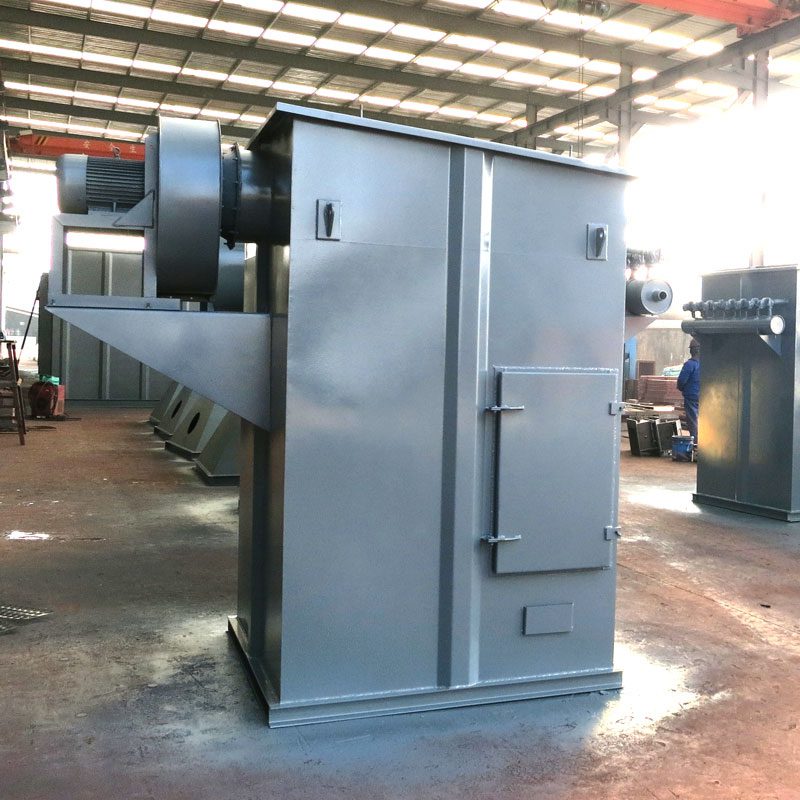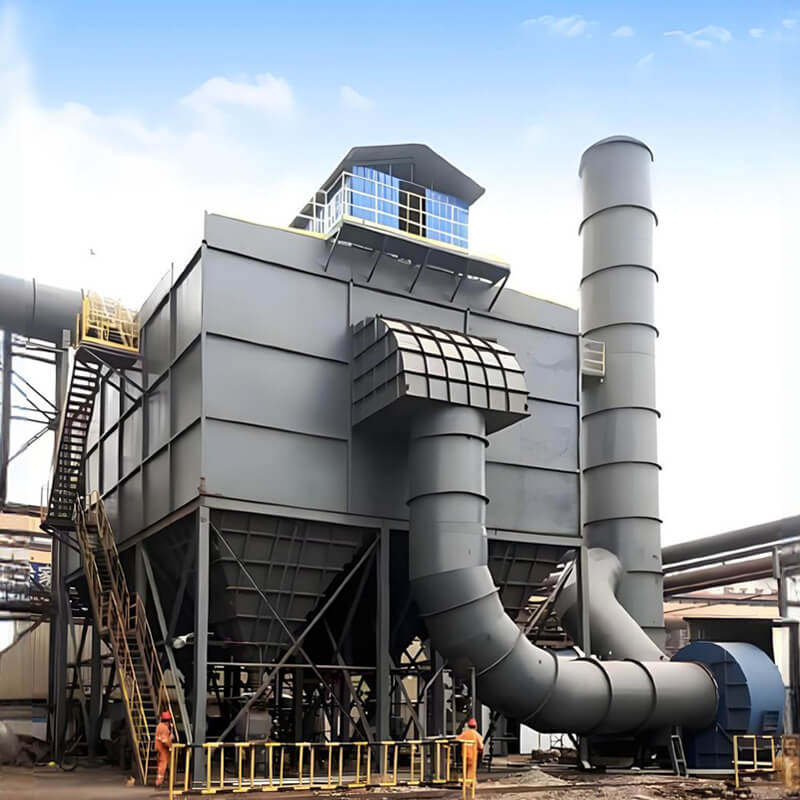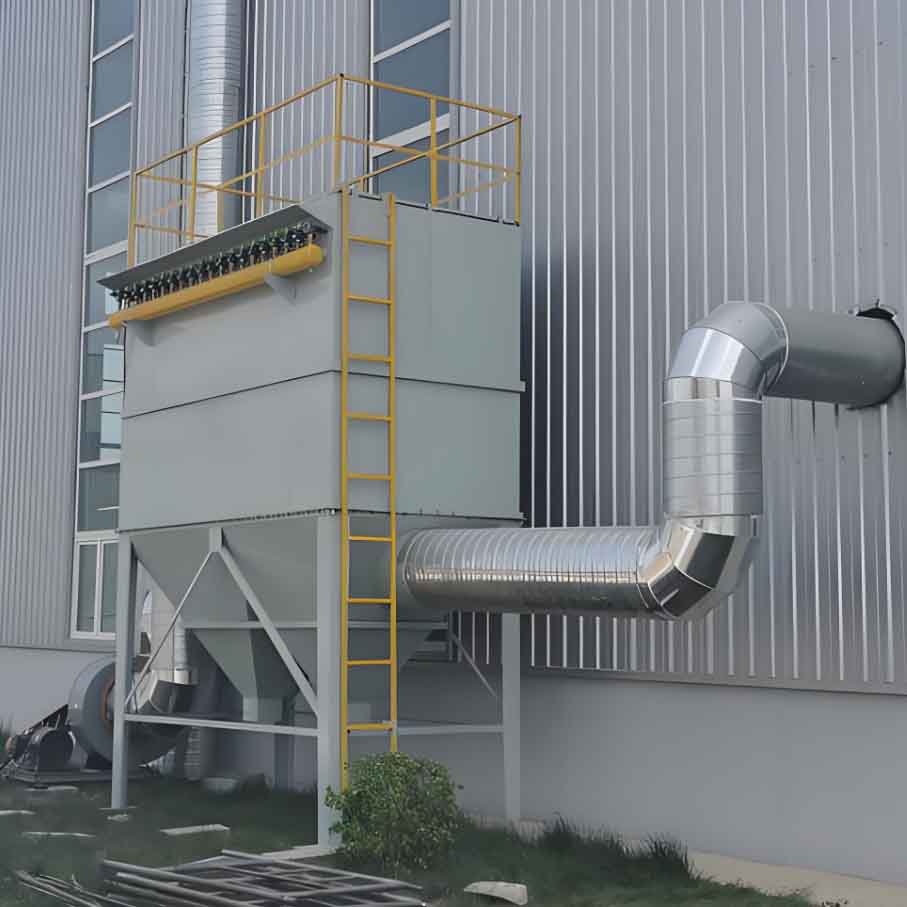O filtro de mangas de jato pulsante é um dispositivo de recolha de poeiras altamente eficiente, com uma eficiência de remoção de poeiras superior a 99%. Este equipamento capta eficazmente as partículas finas, controlando a concentração de poeiras nas emissões para valores inferiores a 10 mg/m³, garantindo um ar limpo.
O coletor de pó de saco é muito adaptável. Consegue lidar com taxas de fluxo de ar de dezenas de milhares a centenas de milhares de metros cúbicos por hora. Este coletor de pó de jato de pulso é amplamente utilizado em indústrias de alta poluição. Por exemplo, é essencial em aço, cimento, produtos químicos e potência geração. Além disso, actua como um coletor de materiais em processos como a produção de cimento, o fabrico de negro de fumo e o processamento de alimentos para animais.
Estrutura e princípio de funcionamento
O coletor de pó de saco de impulsos é composto por vários componentes principais:
- Sistema de limpeza
- Câmara de recolha de poeiras selada
- Quadro principal
- Tremonha de pó
- Sistema de controlo elétrico operacional
Função dos sacos de filtro de pó
Durante o funcionamento, o gás carregado de pó flui através dos sacos de filtro do coletor de pó. As folgas entre as fibras do filtro retêm as partículas maiores do que o diâmetro da folga. A poeira adere à superfície do filtro neste processo, conhecido como peneiramento.
Inicialmente, os novos sacos de filtro têm maiores espaços entre as fibras, o que resulta numa fraca eficiência na recolha de poeiras. Com o passar do tempo, uma camada espessa de pó acumula-se na superfície do filtro, aumentando o efeito de peneiramento. Após o processo de recolha de poeiras, algumas poeiras residuais permanecem na superfície e no interior dos sacos de filtro. Isto permite que o filtro mantenha uma boa eficiência na recolha de poeiras. Materiais como feltro agulhado ou tecido de filtro de pelúcia formam uma camada densa e porosa. Isto optimiza o efeito de filtragem e não depende apenas da camada de pó.
Processo de recolha de poeiras
A limpeza dos sacos filtrantes é efectuada com ar comprimido. O sistema de limpeza é composto por um depósito de ar, um tubo de sopro e uma válvula de controlo de impulsos electromagnéticos. Cada fila de sacos de filtro tem um tubo de sopro equipado com um bocal direcionado para o centro do saco de filtro. Cada tubo de sopro tem uma válvula de impulso ligada ao depósito de ar comprimido.
Durante o processo de limpeza, a válvula electromagnética abre a válvula de impulso, permitindo que o ar comprimido flua através do bocal para o saco do filtro. O ar, juntamente com o gás circundante, entra no saco do filtro, fazendo-o vibrar e criando um fluxo de ar invertido de dentro para fora, removendo eficazmente o pó da superfície exterior do saco do filtro.
O método de limpeza por jato de impulsos gera a maior energia de remoção de poeiras. É um método típico de limpeza externa que tem uma forte capacidade de limpeza e minimiza o pó residual nas fibras do saco de filtro. Os sacos de filtro são normalmente feitos de feltro ou de tecidos perfurados por agulha. A ação do jato de impulsos provoca uma deformação notável dos sacos de filtro, gerando uma tensão significativa. Por conseguinte, o material do filtro deve ter uma elevada resistência à tração. Para além disso, a fricção frequente entre os sacos de filtro e a sua estrutura de suporte requer materiais duráveis, tais como sacos de filtro resistentes ao desgaste ou tecidos.
Tipos de métodos de limpeza
Os filtros de mangas podem ser classificados em três categorias com base nos seus métodos de limpeza:
-
Tipo de vibração mecânica
Este tipo tem uma estrutura simples e um funcionamento fiável, mas a sua eficiência de limpeza é baixa e pode facilmente danificar os sacos de filtro. Por isso, este método de limpeza é utilizado com menos frequência. -
Tipo de jato invertido
Este tipo pode ainda ser dividido em jato invertido de câmara e jato invertido de bocal.- Câmara de jato invertido: Esta conceção utiliza uma estrutura de câmara para introduzir ar limpo da atmosfera ou do sistema de recolha de poeiras em diferentes câmaras de sacos para limpeza. No entanto, a sua eficiência de limpeza é baixa e o custo de investimento é elevado.
- Bico Reverse Jet: Este tipo utiliza um ventilador ou compressor de alta pressão para fornecer um fluxo de ar invertido para limpeza através de um bocal móvel. Embora tenha uma forte capacidade de limpeza, é complexo e dispendioso, com um elevado risco de danificar os sacos de filtro.
-
Tipo de jato de impulsos
Este tipo pode ser classificado com base na pressão do ar injetado em baixa pressão (inferior a 0,25 MPa), média pressão (0,25 MPa a 0,5 MPa) e alta pressão (superior a 0,5 MPa). Também pode ser dividido em tipos de jato de pulso rotativo e jato de pulso em linha.- Jato de impulso rotativo: Este tipo utiliza uma estrutura modular e pode efetuar uma limpeza em linha ou fora de linha. Tem menos válvulas de impulso e funciona de forma fiável, mas a sua complexidade exige uma instalação e manutenção rigorosas.
- Jato de impulsos em linha: Também conhecidos como colectores de poeiras por impulsos de jato tubular, os tubos de sopro são fixados na parte superior do coletor. O tubo de sopro de cada válvula de impulsos tem normalmente vários bicos direcionados para os sacos de filtragem por baixo, permitindo uma limpeza eficiente por jato de impulsos. As suas vantagens incluem uma estrutura simples, menos peças móveis, baixas taxas de falhas e um funcionamento fiável. Pode conceber de forma flexível a distribuição de sacos de filtro de acordo com os requisitos do processo, resultando em baixos custos operacionais. Também assegura uma pressão de limpeza suficiente no fundo dos sacos de filtro utilizando ar comprimido. Os custos globais são baixos, e os colectores de pó de saco do tipo câmara podem realizar manutenção em linha. No entanto, este tipo requer mais válvulas de impulso.
Factores que afectam a eficiência
Vários factores influenciam a eficiência dos filtros de mangas pulsantes:
- Caraterísticas do pó: O tamanho e a densidade das partículas afectam o desempenho da filtragem.
- Qualidade do material de filtragem: A qualidade do material tem um impacto direto no desempenho global.
- Velocidade do fluxo de ar: As definições corretas podem melhorar significativamente as taxas de captura.
- Design: Uma disposição bem planeada das entradas e saídas ajuda a evitar ineficiências.
- Método de limpeza: Uma limpeza eficaz é crucial para manter o desempenho do saco de filtro.
Importância da manutenção
As inspecções regulares são essenciais para conseguir um funcionamento ótimo dos colectores de pó de saco pulsante. A manutenção da câmara de recolha de pó, o aperto dos parafusos para evitar fugas e a substituição regular dos vedantes gastos contribuem para prolongar a vida útil do equipamento.


Porquê escolher a Darko?
Em DarkoA nossa empresa dedica-se ao fabrico de maquinaria e equipamento de cimento de alta qualidade. Concentramo-nos em fornecer soluções amigas do ambiente, incluindo filtros de saco de jato de pulso avançados. A nossa linha de produtos inclui silos de cimento, sistemas de carregamento a granele válvulasTodos concebidos para melhorar a sua eficiência operacional e sustentabilidade.
Conclusão
O filtro de mangas de jato pulsante é indispensável em ambientes industriais. Garante ar limpo, protege a saúde pública e melhora a qualidade dos produtos. Ao escolher o equipamento de recolha de poeiras adequado, está a contribuir significativamente para uma produção limpa e para o desenvolvimento sustentável. Se tiver dúvidas sobre o filtro de mangas pulse jet ou sobre os nossos produtos, não hesite em contactar-nos. contactar-nos!


